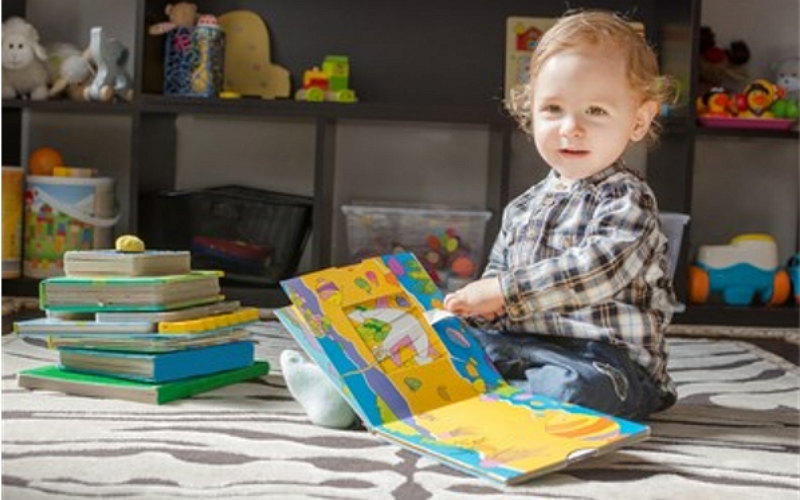How to read to baby when he wants to eat the book? By the time baby is eating solids, he’s also developing a taste for books!
Here are a few tips on how to encourage your little one to enjoy reading time:

Make sure you have some good quality, age-appropriate books. Baby will probably be most interested in bright colors and pictures of other babies or animals.
Sit down with the baby in your lap and let him hold the book. He may try to put it in his mouth, but that’s okay! Just keep reading and talking about the pictures.
Encourage baby to turn the pages himself. You can help by holding the book open and pointing to each page as you read it.
Don’t worry if the baby doesn’t seem very interested at first. Just keep reading and talking in a calm, soothing voice. Over time, he’ll start to enjoy the stories and the time you’re spending together.
Do you have any other tips for reading with a baby? Share them in the comments below!
How do you illustrate a book you can’t draw?
I was recently asked this question by a friend, and it’s a good one. How do you illustrate a book when you can’t draw?
The answer is simple: you find someone who can.
There are many ways to find an illustrator for your book. You can put out a call for submissions, or you can approach artists directly. Whichever route you choose, make sure you take the time to look at portfolios and find an artist whose style meshes well with your vision for the book.
Once you’ve found an artist whose work you like, it’s time to start talking about what exactly you need them to do. Be as specific as possible; the more information you can give, the better.
Will they be illustrating every page or just a few key scenes? Will they need to create character designs as well as illustrations? What style should the illustrations be in?
All of these questions are important to answer upfront so that there are no surprises down the road. It’s also helpful for the illustrator to have a sense of who your target audience is since this will influence the tone and look of the illustrations.
Once all of that is settled, it’s time to get started on those illustrations! The illustrator will likely send you rough sketches before starting on the final product, so make sure you give them feedback along the way.
And finally, enjoy your beautifully illustrated book! You may also check related articles such as How to keep track of who fave book to baby and What book would you bring to a baby shower for baby for tips and guides.
What should you not do when writing a children’s book?
There are a few things you should avoid if you want to write a successful children’s book. First, don’t make the book too long. Children have short attention spans, so you need to keep the story concise.
Second, stay away from complicated words and concepts. Keep the language simple so that young readers can understand it. Finally, don’t forget to include plenty of illustrations. Kids love pictures, and they can help break up the text and make the story more engaging.
If you follow these tips, you’ll be well on your way to writing a great children’s book! Good luck!
Is it hard to write a children’s book?
There is no right or wrong answer to this question, as it depends on the author’s individual preferences and writing style.
However, many authors find that writing children’s books can be more difficult than writing for adults since the content must be both entertaining and educational for young readers.
One common challenge is striking the right balance between including too much or too little information in a story. Too much detail can overwhelm kids and cause them to lose interest, while not providing enough information can leave them confused.
Additionally, authors must ensure that their stories are age-appropriate, avoiding topics or language that might be too complex or confusing for younger readers.
Finally, another difficulty of writing children’s books is capturing the reader’s attention from beginning to end. Kids have shorter attention spans than adults, so it’s important to keep the story interesting and engaging throughout.
This can be a challenge, but it’s also one of the things that make writing for kids so rewarding. When done well, children’s books can ignite imaginations and inspire a love of reading in young readers.
How do you write a children’s book rhyme?
There isn’t a set formula for how to write children’s book rhyme, but there are some things that will help make your writing more rhyming and kid-friendly.
First, try to come up with a catchy title that rhymes. This will help get your child’s attention and make them more likely to want to read the book.
Then, try to come up with a story idea that is easy enough for a child to understand, but still has some depth and complexity. Keep your sentences short and sweet, using simple words whenever possible. And be sure to use repetition throughout the story so that kids can easily follow along.
Finally, when it comes time to write the rhyming text itself, there are a few things to keep in mind. First, try to make your rhymes as close to perfect as possible – the closer they are, the better they will sound when read aloud.
Second, don’t be afraid to use different rhyming schemes throughout the book – this will help keep things interesting and prevent the reader from getting bored.
